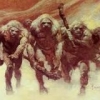Leaderboard
Popular Content
Showing content with the highest reputation on 09/26/2016 in all areas
-
During the past few decades of investigating reports and conducting research concerning the presence of Bigfoot in the Southern and Southeastern states, I routinely receive information and see evidence that clearly indicates that the primates relish fruits, berries and vegetables from any source. A recent contact with an older gentleman who lives in Southern Missouri who is aware that a group of Bigfoot have foraged on his and a neighbor’s property for years, told me about Bigfoot taking his entire grape crop. The man was not as upset about the overnight theft of his crop of fruit as he was about the Bigfoot’s antics with his two-piece, concrete bird bath. During the hot weather the man filled the birdbath with cold water each afternoon. Every few mornings he would discover the concrete bowl had been removed from its pedestal and brought and set down on the ground near the home’s back door. The first time that occurred he was not sure that someone was not “playing a prank” on him. The man stated the act was not funny to him because he had to carry the heavy bowl and re-install on the pedestal. He complained the he was, “Too danged old to be lifting and carrying the thing and set it back in place every few days.” He had known a group of Bigfoot came onto to his property every few night because he had heard them “hollering, whooping and beating on trees after dark”. He had no problem with them doing that, and had left apples out for them in the back yard in the area of the bird bath. When he continued to find the birdbath bowl on the ground by the back door for a “refill” he became frustrated by the animals’ antics. He didn’t discuss the situation with anyone until his whole crop of grapes – he said a few bushel – disappeared overnight and he found wide, 18” long bare foot prints in the vineyard. At that time he decided to talk to a neighbor who lived about one-quarter mile away. He approached the man by asking him if he had heard any strange animals sound at night. The man told him he had not only heard them many times at night but at times they were close enough to his home that he had determined there were at least five in the group. He told the man that the animals were those called MO-Mo in that state and Bigfoot in other place. During their discussion the neighbor also told him that he had a peach tree that had such an abundance of fruit this season he cut small forked trees from his property to prop up the heavy loads of fruit on the peach tree limbs to keep the limbs from breaking. The neighbor stated that when the fruit ripened he discover that all of the peaches were picked or shaken loose from the tree and carried off during one night. There was no evidence that a human or wild animal had climbed the tree. Both men realized that typical wild animals would eat their fill at the site, and evidence of that would have been obvious on the ground under the tree. There have been numerous reports of Bigfoot sightings from that county in Missouri that have been submitted to well known Bigfoot research groups. The writer has conducted field work in that area, and recorded reports from several respected area residents. This man’s report is typical of many others that I have investigated in various states– except for the birdbath aspect - that is a new wrinkle for me. The other slight differences in the other reports were that the cultivated fruits stolen were usually apples, pears, plums and, in one instance, figs. The most well known case of a Bigfoot foraging on cultivated fruit occurred in a large peach orchard in Chilton near Clanton, Alabama in the 1960s. The orchard’s owner called the county sheriff’s office and reported the routine theft of peaches on the back side of the orchard near the wood line.. An investigator from that office went to the scene. He saw and photographed very large, human-like tracks in the sandy soil. He followed the tracks into the woods and was convinced it was not a human that stole the peaches and left the tracks. The investigator did not mince words. He told the local newspaper reporters what he saw and gave them his opinions. The story was widely covered by TV stations and other newspapers. There have been several cases that I’ve investigated that involve the theft of garden produce by one or more Bigfoot. During the summer months reports of Bigfoot swiping tomatoes, corn in the roasting ear stage, water melons and cantaloupes from gardens in rural areas of the S & SE are fairly common. During the winter they often take turnips and winter onions. In a majority of such cases, the evidence that it was Bigfoot that raided the gardens was their footprints left in the tilled ground. The primary reason for this post is to alert younger Bigfoot “hunters” that their quarry routinely forages on wild fruits and berries, and very often leaves distinctive evidence of the act. Many years ago I first heard one of the animals vocalize about eleven PM on a very cold night in December. For five years I devoted my spare time to try to determine for sure what made that sound. Although I had seen unusual sign and smelled odd and rank odors that I now know were Bigfoot related, it was not until I saw their huge tracks in the thick grass around the perimeter of an “island” of fruit laden blackberry vines that disclosed their identity. In closely examining that blackberry thicket it was obvious the thicket of vines were undisturbed and that for a distance of over three feet inside the perimeter of the thicket nearly all of the ripe berries had been picked. The tracks in the grass closely adjoining the perimeter showed the Bigfoot had taken steps of about four feet, stopped, brought both feet together and reached over the six to seven feet high vines to gather the ripest berries. His tracks showed that the animal approached the exposed blackberry patch from a nearby creek bottom, and returned to the creek bottom when he had eaten the berries within his reach around the edge of the patch. As a point of fact, had it been a black bear that found the berry thicket first, the thicket of vines would have looked as if an ATV had been driven through the entire patch. I have found many good blackberry patches and kept track of the berries’ growth with the intention of harvesting them to make jelly when they were ripe. The black bears beat me to them most of the time. One large patch I was watching was growing in an old clear-cut area near the top of a mountain. The road up the mountain was rough, rutted and in places covered with silt washed off the mountainside. When I knew the berries would be ripe I made rough drive up the mountain. Just before I reached the berry thicket I passed over a layer of red clay. I knew I was wasting my time. I stopped to look at the tracks of a sow bear and her two cubs that were headed toward the patch. I drove to the berry patch as that was the nearest place to turn around. The pristine berry patch looked as if a tornado had flattened it. Many times I have seen medium to large size black cherry trees with the limbs broken off when the fruit was ripe. I always stop to see for sure if it had been a bear, as is usually the case, did the damage. If so, the limbs will have been pulled across the ground to form somewhat of a circle, with the center of the circle showing a large impression of the bear’s butt. A bear will sit on the ground and gorge itself on the fruit. There always seems to be enough berries left for the coyotes. The cherries are a laxative of sorts because the animal trails, roads or open woods near the site are speckled with runny coyote and bear scat. A bear will always leave the marks of its claws on any tree it climbs; but a Bigfoot seldom leaves toe or fingernail marks when they do that. When a Bigfoot climbs a large wild fruit tree they will seat themselves and bend the fruit bearing limbs close enough to strip the fruit from the limbs and branches with their mouth. The evidence on the ground will be a sprinkling of mashed cherries, fruit stems and lacerated leaves. When smaller cherry trees are found with fruit, and they want it, they will break the tree several feet from the ground. Usually the tree top is drug to a more concealed spot if it was growing in an open area. Many animals forage on the several varieties of wild grapes that grow in this part of the country. Muscadine grapes will mature and bear fruit when the small vines grow along the ground without support. The fruit from such vines is easy pickings for all animals, including humans. (The fruit makes excellent jelly and wine.) Large muscadine vines that grow up alongside or wrapped around the sides of large trees may reach a height of a hundred feet or more, with multiple branches from the ground upwards. Coyote, fox, raccoon, opossum, black bear, and feral hogs forage heavily on the fruit. Bigfoot does as well, although because of the relatively small population of these animals and the vast and widespread growth of the vines it is rare to find compelling evidence of those animals foraging on muscadine fruit. It is not unusual to find a muscadine vine when the fruit is ripening and see that the vine has been manipulated to cause a lot of both the ripe and green fruit to fall to the ground. Several times I have noticed this situation and spent time determining the cause, Most of the time I could plainly see teeth marks on the lower parts of the vines. Tracks and scat in the area confirmed that a coyote had actually jumped off the ground to grasp the vines with its teeth, and no doubt shook its body to cause fruit to fall. The mature fruit was obviously eaten, but the green, hard fruit was left on the ground. Their teeth marks showed they had grasped the vine, shook it and simply turned loose of it; in other words the teeth did not slip down the vine. In other such cases it was obvious that bear had pulled and shook the vines with both their teeth and paws. In one case a bear had clawed, chewed and pulled on a huge vine for some time without dislodging much fruit because the vine was tightly wrapped around a huge pine tree. Only once have I seen a wild grape vine from which appeared a Bigfoot had removed the fruit, and the fruit was summer grapes. The vine was growing up a small maple tree (about six or eight inches in diameter) near the top of steep ridge which was capped by a sheer sandstone cliff. Below the face of the cliff was a small natural clearing covered by rocks and boulders with some grass and small brush. The tree had been near the center of the small clearing, and was covered by the vines of a summer grape. When I found it in September a few years ago, it had been broken off about five feet from the ground. The top part, with the vine and its roots attached, had been taken about twenty yards and placed against the base of the cliff. At that location there was a flat, protruding ledge that was about five or six feet above the cliff base. It was obvious the tree and vine had been moved fairly recently as there were still some dried leaves attached to both the tree and vine. There were a few dried grapes still attached to the vine, and some on the ground rocks below the ledge. Below the ledge was also a localized mixture of grape stems, leaves small broken limbs from both the maple tree and the summer grape vine. Along the base and sides of that cliff, which extends nearly one half mile, there are numerous ledges that are similar to the one described. All of those ledges are covered by the duff from northern red oak and pine trees that grow in broken gaps along the top of the cliff. It was noted that most of the accumulated duff on the ledge near which the tree top was placed was nearly gone, and what was left had been disturbed. The ironic thing to me was in this very area, nearly fifty years ago, I walked the length of the top of that cliff for the first time, at times having to walk on tree limbs to get across the gaps. It was only a few hundred yards from this natural clearing that I climbed down to the base of the cliff and on my way to the base of the ridge. When I reached the base of the cliff I immediately smelled the most disgusting and obnoxious odor I had ever encountered in the woods at that time. I thought the smell might have originated from a coyote den, but when I began looking around for one, the odor became fainter and fainter until it was gone. Just memories and observation I wanted to share while I still can. Kindest regards to all.1 point
-
The interesting thing I found regarding woodwose in art (google / images) are the facial characteristics. Very very human. Nothing monkey or ape-like. Also nothing similar to demon faces in art of similar time periods. That said ... people draw what they learn to draw and they apply the thing they know when confronted with the unknown. Consider how much seeming European, though heavy, features seem to intrude into Harvey Pratt's bigfoot drawings ... much as you'd expect of a very skilled forensic artist used to drawing human features. The frequency of woodwose with thin, northern European looking features may simply reflect what the artists of the time assumed ... a period convention, perhaps. MIB1 point
-
Loud is a pretty relative terms. My bet is that most of the loud, long woman-like screams is from foxes. It is amazing the sounds that can come out of those little critters. However, they cannot match a BF for shear volume. I heard a female banshee like scream last winter that was so loud that its echo was loud enough off the opposite shoreline I initially thought it was a second scream. No known animal can make a sound as loud as that scream. BTW, my interest in BFs was really started when I heard an "Ohio howl" late one afternoon when riding my bike up a remote hill. It was loud and long, but far enough away it was not threatening, and I can clearly remember working through every known animal in NJ trying to figure out the match without success. It was not until later that I found the sounds on the internet that I made the match to BF.1 point
-
Being that Orangutans reside in Micronesia and not Europe? I'm not surprised. Thanks for sharing.1 point
-
I think that is normal for some people. They evidently didn't realize they were in the food chain the minute they parked the car. And it just takes one scary encounter to end it all for them, even Bears, Cougars, forest fire or a Mule wreck. I try to live by the mantra that it's ok to be afraid. It's not ok to let it run your life.1 point
-
^^^As a Nation (U.S. that is) we might be waking up to the factual vacuum created by the whole idea of false equivalency. This is the pernicious idea that any fact stated is balanced out by the mere statement to the contrary. There is no end to the mischief this creates and it sustains an atmosphere of "anything goes, and nothing matters." If I were to say, "The sun rises in the East, and sets in the West" and your reply is NUH-UHHH!!!, and both "views" are proposed as having equal legitimacy, we are four-square in the upside-down world of the false equivalency. So....to bring it around to the topic at hand...if I say to you , "Look, there are gigantic footprints that were obviously made by something big, with a lot of mass, and with a preternaturally long stride", and your reply on looking at them is: "No they weren't, because the animal you reference is mythical"? One of us has factual issues. It would not be me.1 point
-
He already does that, and does a dang nice job of documenting it as well I think. His research section is full of photos, video and audio from the field. And let's not forget his tireless work with the SSR, as well as the BFF. Gigantor is one of the most important unsung person this subject has.1 point
-
As part of the agreements between myself and witnesses who have asked that I personally investigate their enigmatic animal encounters, the locations of the events are not publicly disclosed for all the reasons you have listed plus others. Those four BF research groups that have requested that I investigate reports they receive bind me by a confidentially agreement from releasing information about the name of the witnesses, their addresses and the locations of the encounters if they occurred on private property, primarily for the same reasons you so clearly described. In response to Gig's "easy to track them" question; yes, it would be easy if the witnesses actually wanted to do that quickly after the theft of the fruits/berries. Not so surprisingly, danged few of them that were aware of what had swiped the food stuff cared to follow fresh tracks and encounter a family group of big hairy primates and interrupt the their hard earned meal. In most cases the investigators don't reach the scene for weeks or more after the event, and the trail of tracks and dropped produce may be hard to find and follow. Most folks that have these experiences could care less about "providing evidence" of BF's existence to skeptics who like to pile and heap their meaningless opinions that BF is a myth all over the internet. Those "all knowing folks" with little or no experience with real. day-and night 'boots on the ground" fieldwork are simply like pesky gnats; not much you can do but listen and watch them buzz. Thanks for your spot on post NCBFr.1 point
-
Great apes' diets don't vary much from species to species. Gorillas, orangutans, chimps, bonobos, and even (as far as we can tell) pre-agricultural humans all eat/ate diets of mostly fruits and vegetation (leaves, nuts, tree bark, etc.), with protein playing a smaller - although certainly important - role in their diets. While I'm sure that a sasquatch could kill and eat larger animals like deer, and probably do so from time to time, I don't see why we should expect them to be different from other great apes in terms of diet. I'm not aware of many accounts that describe the eating habits of alleged sasquatch, but one of the more famous accounts that does, the William Roe account, describes an animal which is sitting and eating leaves in much same manner as orangutans do. While many other posters are using examples of estimated caloric requirements - and are making strong cases for the manner in which they are making those estimates - I think we should remember that the caloric requirements of great apes can be quite seasonal. This paper (note: hyperlink opens a PDF) describes how orangutans have been observed to gorge themselves on fruit during seasons when fruit is plentiful, consuming some 8,422 calories a day for males and 7,404 calories a day for females. In seasons when food is less readily available, the orangutans consume foods like bark and consume far fewer calories each day, 3824 calories for males and 1793 for females. These periods of low fruit availability can last for years, and this article describes how orangutans' bodies consume their fat reserves and muscles during lean years. Given these examples, I don't find it difficult to imagine a sasquatch eating a diet composed mostly of fruits, vegetation opportunistically eating other proteins (grubs, insects, small mammals, fish, and even occasionally things like deer), gorging on those foods in the flush spring and summer months, eating the more readily available foods like nuts, bark, and perhaps roots like cattails in the autumn, and then drastically limiting its physical activity and living off fat and muscle reserves through the winter.1 point
-
I agree 100%. We should create a "reference" thread with known animal sounds so that everyone can have a basis for comparing what we record or hear. I think it would be helpful.1 point
-
What I wonder when I read this type of report, is how do they manage the large quantities of loose food. Armloads? Bring all the juvenile laborers? Have you ever heard tell of large vessels such as buckets disappearing? In the NW I've heard are sometimes found piles of seafood shells away in the forest. Anyway, thank you Mr B, it's always a pleasure to read your accounts. Looking forward to your next book.1 point
-
There seems to be a common theme among researchers that any circumstantial evidence they present will be "torn to shreds" by skeptics and made fun of. I think this is incorrect. It happens when people present their findings as a fact that it was BF related. I think the presentation has a lot to do with how it is received by the community. For example. When people say: "We got a recording of BF howling and we've eliminated every other possibility" and take it personally when somebody objects, it won't go well. On the other hand, if one presents the same recording as "we recorded something interesting, it could be a BF, but we're not sure", it will get a much better reception and respect. Objectivity in your own data is key. Frankly, you should be the harshest critic of your data, because you collected it and know more about it than anyone else. You should be looking to poke holes into it and look for holes other people identify instead of trying to defend it. You may end up dismissing the objections, but they are valuable feedback. You want the greatest number of eyeballs on it. If you're straight up about it, people will recognize you are just presenting what you got. Instead of making claims about it, just lay it out there, it is what it is. Everyone benefits by learning from it. It's certainly been the case in my experience.1 point
This leaderboard is set to New York/GMT-05:00







